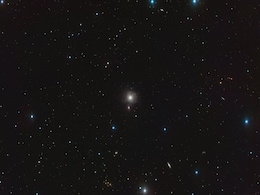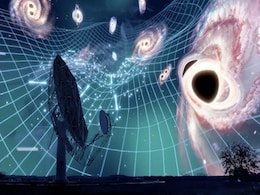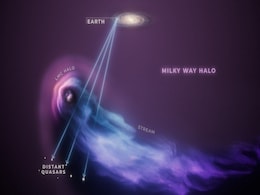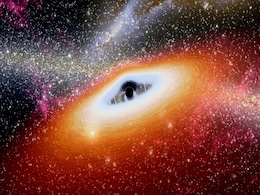Cosmic Collisions
- All
- News
-

Supernova Remnants Found in Oceanic Samples, Scientists Look to Moon
- Wednesday March 26, 2025
- Written by Gadgets 360 Staff
Scientists have identified supernova debris in deep-sea sediments, including a rare plutonium isotope linked to a kilonova. Researchers believe a neutron star collision occurred nearly 10 million years ago, scattering radioactive material across space. To validate this theory, they plan to analyze lunar soil, which remains undisturbed by Earth's ge...
-
 www.gadgets360.com
www.gadgets360.com
-

Mysterious Planetary-Mass Objects May Form in Young Star System Clashes
- Wednesday March 12, 2025
- Written by Gadgets 360 Staff
Recent research challenges traditional views on planetary-mass objects, suggesting they may form through violent interactions between young star systems rather than standard planetary or stellar processes. Simulations indicate these clashes create dense gas filaments that evolve into free-floating objects, often in binary pairs. This discovery expl...
-
 www.gadgets360.com
www.gadgets360.com
-

Astronomers Spot Galaxy NGC 3640 With a Past of Consuming Smaller Galaxies
- Tuesday February 25, 2025
- Written by Gadgets 360 Staff
Recent observations of NGC 3640 reveal a history of merging with smaller galaxies. Located 88 million light-years away, the elliptical galaxy is suspected to be on a collision course with NGC 3641. The Very Large Telescope captured structural distortions, hinting at previous mergers. Researchers have identified ancient stars acting as fossil marker...
-
 www.gadgets360.com
www.gadgets360.com
-

Strange Fast Radio Bursts Emerge from an Ancient Dead Galaxy, Baffling Scientists
- Monday February 24, 2025
- Written by Gadgets 360 Staff
Scientists have detected mysterious fast radio bursts (FRBs) from the outskirts of an 11 billion-year-old dead galaxy. This discovery challenges the belief that FRBs primarily originate from young, star-forming galaxies. Researchers suspect the bursts may result from colliding stars or a collapsing white dwarf. The Canadian Hydrogen Intensity Mappi...
-
 www.gadgets360.com
www.gadgets360.com
-

Gravitational Waves Reveal Black Hole Ancestry Through Spin Analysis
- Monday February 3, 2025
- Written by Gadgets 360 Staff
A study published in Physical Review Letters explores how gravitational waves reveal the ancestry of black holes. By examining 69 black hole mergers, researchers found that spin shifts indicate repeated collisions in dense star clusters. This insight supports models suggesting black holes grow through sequential mergers. Observatories like LIGO and...
-
 www.gadgets360.com
www.gadgets360.com
-

New "Kiss-and-Capture" Theory Explains Pluto's Formation of Largest Moon, Charon
- Wednesday January 8, 2025
- Written by Gadgets 360 Staff
A new theory proposes that Pluto’s largest moon, Charon, was formed billions of years ago through a rare "kiss-and-capture" collision in the Kuiper Belt. This process involves two icy bodies briefly merging and then separating, leaving Charon in a stable orbit around Pluto. Unlike traditional collision models, this event challenges previous theor...
-
 www.gadgets360.com
www.gadgets360.com
-

MeerKAT Detects Gravitational Wave Background, Uncovering Cosmic Activity
- Friday December 27, 2024
- Written by Gadgets 360 Staff
Scientists using the MeerKAT Pulsar Timing Array have made a groundbreaking discovery, confirming the presence of a gravitational wave background in the universe. This unexpected phenomenon, detected with unprecedented precision, suggests that supermassive black hole collisions may occur more frequently than previously thought. By observing the sig...
-
 www.gadgets360.com
www.gadgets360.com
-

NASA's Hubble and Chandra Telescopes Spot Strange Tilted Black Hole
- Tuesday December 24, 2024
- Written by Gadgets 360 Staff
NASA’s Hubble and Chandra telescopes have uncovered a bizarre sideways black hole in the galaxy NGC 5084, located 80 million light-years away. The black hole’s unexpected tilt suggests it may have been influenced by a violent galactic collision. A new image processing technique, SAUNAS, revealed X-ray plumes in the galaxy, hinting at a cosmic e...
-
 www.gadgets360.com
www.gadgets360.com
-

Hubble and Chandra Telescopes Spot Strange Tilted Black Hole in Galaxy NGC 5084
- Tuesday December 24, 2024
- Written by Gadgets 360 Staff
NASA’s Hubble and Chandra telescopes have uncovered a bizarre sideways black hole in the galaxy NGC 5084, located 80 million light-years away. The black hole’s unexpected tilt suggests it may have been influenced by a violent galactic collision. A new image processing technique, SAUNAS, revealed X-ray plumes in the galaxy, hinting at a cosmic e...
-
 www.gadgets360.com
www.gadgets360.com
-

Distant Galaxies Crash to Produce Massive Sonic Boom, Could Reveal Secrets About the Universe: Report
- Tuesday November 26, 2024
- Written by Gadgets 360 Staff
The galaxy NGC 7318b has collided with its neighbours in Stephan’s Quintet, creating one of the most powerful shockwaves observed in space. The resulting debris, glowing plasma, and star formation are being studied using advanced spectrographic tools, offering rare insights into galaxy formation and evolution.
-
 www.gadgets360.com
www.gadgets360.com
-

Hubble Telescope Reveals Milky Way Blowing Gas off LMC Galaxy in Close Encounter
- Monday November 18, 2024
- Written by Gadgets 360 Staff
NASA’s Hubble Space Telescope has captured an extraordinary phenomenon as the Milky Way galaxy exerts ram pressure on the Large Magellanic Cloud (LMC), stripping away most of its gas halo. The interaction, which occurs as LMC passes near the Milky Way, has led to the loss of significant mass from the dwarf galaxy. Despite this, LMC retains enough...
-
 www.gadgets360.com
www.gadgets360.com
-

Hubble Telescope Captures Image of Merging Galaxies in Coma Cluster, 390 Million Light-Years Away
- Monday November 18, 2024
- Written by Gadgets 360 Staff
NASA and the European Space Agency (ESA) have shared an image of two galaxies, MCG+05-31-045, interacting within the Coma Cluster. Located 390 million light-years away, the pair is in the midst of a cosmic merger. As the smaller galaxy is pulled into the larger one, a new wave of star formation is expected. Over time, the galaxies will likely evolv...
-
 www.gadgets360.com
www.gadgets360.com
-

Black Hole Mergers Explained: What Happens When Two Black Holes Collide in Space?
- Tuesday October 22, 2024
- Written by Gadgets 360 Staff
Black hole mergers are among the most energetic events in space. Two black holes gradually lose energy through gravitational interactions, drawing them closer until their event horizons stretch and merge. Gravitational waves released during the process are some of the most powerful forces in the universe, with part of the black holes' mass converti...
-
 www.gadgets360.com
www.gadgets360.com
-

Supermassive Black Hole at the Centre of the Milky Way Is Spinning Unexpectedly
- Sunday September 15, 2024
- Written by Gadgets 360 Staff
Sagittarius A* (pronounced Sagittarius A Star), the supermassive black hole at the centre of the Milky Way, is spinning in an unusual way, and scientists now believe they may know why. Based on new data from the Event Horizon Telescope, researchers suggest that this cosmic giant likely merged with another black hole billions of years ago. This colo...
-
 www.gadgets360.com
www.gadgets360.com
-

Milky Way and Andromedia Fated Collision Might Not Happen, Reveals New Study
- Sunday August 25, 2024
- Gadgets 360 Staff
Recent research has cast doubt on the certainty of the Milky Way-Andromeda galaxy collision, suggesting the event may not be as inevitable as once thought. Traditionally, astronomers have predicted that our galaxy would merge with Andromeda within the next 5 billion years, creating a new elliptical galaxy often referred to as "Milkomeda." However, ...
-
 www.gadgets360.com
www.gadgets360.com
-

Supernova Remnants Found in Oceanic Samples, Scientists Look to Moon
- Wednesday March 26, 2025
- Written by Gadgets 360 Staff
Scientists have identified supernova debris in deep-sea sediments, including a rare plutonium isotope linked to a kilonova. Researchers believe a neutron star collision occurred nearly 10 million years ago, scattering radioactive material across space. To validate this theory, they plan to analyze lunar soil, which remains undisturbed by Earth's ge...
-
 www.gadgets360.com
www.gadgets360.com
-

Mysterious Planetary-Mass Objects May Form in Young Star System Clashes
- Wednesday March 12, 2025
- Written by Gadgets 360 Staff
Recent research challenges traditional views on planetary-mass objects, suggesting they may form through violent interactions between young star systems rather than standard planetary or stellar processes. Simulations indicate these clashes create dense gas filaments that evolve into free-floating objects, often in binary pairs. This discovery expl...
-
 www.gadgets360.com
www.gadgets360.com
-

Astronomers Spot Galaxy NGC 3640 With a Past of Consuming Smaller Galaxies
- Tuesday February 25, 2025
- Written by Gadgets 360 Staff
Recent observations of NGC 3640 reveal a history of merging with smaller galaxies. Located 88 million light-years away, the elliptical galaxy is suspected to be on a collision course with NGC 3641. The Very Large Telescope captured structural distortions, hinting at previous mergers. Researchers have identified ancient stars acting as fossil marker...
-
 www.gadgets360.com
www.gadgets360.com
-

Strange Fast Radio Bursts Emerge from an Ancient Dead Galaxy, Baffling Scientists
- Monday February 24, 2025
- Written by Gadgets 360 Staff
Scientists have detected mysterious fast radio bursts (FRBs) from the outskirts of an 11 billion-year-old dead galaxy. This discovery challenges the belief that FRBs primarily originate from young, star-forming galaxies. Researchers suspect the bursts may result from colliding stars or a collapsing white dwarf. The Canadian Hydrogen Intensity Mappi...
-
 www.gadgets360.com
www.gadgets360.com
-

Gravitational Waves Reveal Black Hole Ancestry Through Spin Analysis
- Monday February 3, 2025
- Written by Gadgets 360 Staff
A study published in Physical Review Letters explores how gravitational waves reveal the ancestry of black holes. By examining 69 black hole mergers, researchers found that spin shifts indicate repeated collisions in dense star clusters. This insight supports models suggesting black holes grow through sequential mergers. Observatories like LIGO and...
-
 www.gadgets360.com
www.gadgets360.com
-

New "Kiss-and-Capture" Theory Explains Pluto's Formation of Largest Moon, Charon
- Wednesday January 8, 2025
- Written by Gadgets 360 Staff
A new theory proposes that Pluto’s largest moon, Charon, was formed billions of years ago through a rare "kiss-and-capture" collision in the Kuiper Belt. This process involves two icy bodies briefly merging and then separating, leaving Charon in a stable orbit around Pluto. Unlike traditional collision models, this event challenges previous theor...
-
 www.gadgets360.com
www.gadgets360.com
-

MeerKAT Detects Gravitational Wave Background, Uncovering Cosmic Activity
- Friday December 27, 2024
- Written by Gadgets 360 Staff
Scientists using the MeerKAT Pulsar Timing Array have made a groundbreaking discovery, confirming the presence of a gravitational wave background in the universe. This unexpected phenomenon, detected with unprecedented precision, suggests that supermassive black hole collisions may occur more frequently than previously thought. By observing the sig...
-
 www.gadgets360.com
www.gadgets360.com
-

NASA's Hubble and Chandra Telescopes Spot Strange Tilted Black Hole
- Tuesday December 24, 2024
- Written by Gadgets 360 Staff
NASA’s Hubble and Chandra telescopes have uncovered a bizarre sideways black hole in the galaxy NGC 5084, located 80 million light-years away. The black hole’s unexpected tilt suggests it may have been influenced by a violent galactic collision. A new image processing technique, SAUNAS, revealed X-ray plumes in the galaxy, hinting at a cosmic e...
-
 www.gadgets360.com
www.gadgets360.com
-

Hubble and Chandra Telescopes Spot Strange Tilted Black Hole in Galaxy NGC 5084
- Tuesday December 24, 2024
- Written by Gadgets 360 Staff
NASA’s Hubble and Chandra telescopes have uncovered a bizarre sideways black hole in the galaxy NGC 5084, located 80 million light-years away. The black hole’s unexpected tilt suggests it may have been influenced by a violent galactic collision. A new image processing technique, SAUNAS, revealed X-ray plumes in the galaxy, hinting at a cosmic e...
-
 www.gadgets360.com
www.gadgets360.com
-

Distant Galaxies Crash to Produce Massive Sonic Boom, Could Reveal Secrets About the Universe: Report
- Tuesday November 26, 2024
- Written by Gadgets 360 Staff
The galaxy NGC 7318b has collided with its neighbours in Stephan’s Quintet, creating one of the most powerful shockwaves observed in space. The resulting debris, glowing plasma, and star formation are being studied using advanced spectrographic tools, offering rare insights into galaxy formation and evolution.
-
 www.gadgets360.com
www.gadgets360.com
-

Hubble Telescope Reveals Milky Way Blowing Gas off LMC Galaxy in Close Encounter
- Monday November 18, 2024
- Written by Gadgets 360 Staff
NASA’s Hubble Space Telescope has captured an extraordinary phenomenon as the Milky Way galaxy exerts ram pressure on the Large Magellanic Cloud (LMC), stripping away most of its gas halo. The interaction, which occurs as LMC passes near the Milky Way, has led to the loss of significant mass from the dwarf galaxy. Despite this, LMC retains enough...
-
 www.gadgets360.com
www.gadgets360.com
-

Hubble Telescope Captures Image of Merging Galaxies in Coma Cluster, 390 Million Light-Years Away
- Monday November 18, 2024
- Written by Gadgets 360 Staff
NASA and the European Space Agency (ESA) have shared an image of two galaxies, MCG+05-31-045, interacting within the Coma Cluster. Located 390 million light-years away, the pair is in the midst of a cosmic merger. As the smaller galaxy is pulled into the larger one, a new wave of star formation is expected. Over time, the galaxies will likely evolv...
-
 www.gadgets360.com
www.gadgets360.com
-

Black Hole Mergers Explained: What Happens When Two Black Holes Collide in Space?
- Tuesday October 22, 2024
- Written by Gadgets 360 Staff
Black hole mergers are among the most energetic events in space. Two black holes gradually lose energy through gravitational interactions, drawing them closer until their event horizons stretch and merge. Gravitational waves released during the process are some of the most powerful forces in the universe, with part of the black holes' mass converti...
-
 www.gadgets360.com
www.gadgets360.com
-

Supermassive Black Hole at the Centre of the Milky Way Is Spinning Unexpectedly
- Sunday September 15, 2024
- Written by Gadgets 360 Staff
Sagittarius A* (pronounced Sagittarius A Star), the supermassive black hole at the centre of the Milky Way, is spinning in an unusual way, and scientists now believe they may know why. Based on new data from the Event Horizon Telescope, researchers suggest that this cosmic giant likely merged with another black hole billions of years ago. This colo...
-
 www.gadgets360.com
www.gadgets360.com
-

Milky Way and Andromedia Fated Collision Might Not Happen, Reveals New Study
- Sunday August 25, 2024
- Gadgets 360 Staff
Recent research has cast doubt on the certainty of the Milky Way-Andromeda galaxy collision, suggesting the event may not be as inevitable as once thought. Traditionally, astronomers have predicted that our galaxy would merge with Andromeda within the next 5 billion years, creating a new elliptical galaxy often referred to as "Milkomeda." However, ...
-
 www.gadgets360.com
www.gadgets360.com
















